
Having ticked the major Komodo Dragon box for me we decided to take the slow route back to Bali, taking in some of the lesser-known and less touristy places. This meant that rather than hopping a one hour flight from Labuan Bajo we would hop a ferry (many of them in fact) and bounce from island to island on our way back in the general direction of Bali.
So the first thing was to get a ferry. This led to some very strange looks from people as nobody did this. Why would you go to nowhere places, when you can be back to relative civilisation within an hour’s flight. But they weren’t married to Jill, who wanted the adventure. So we moved from our nice hotel to one that was closer to the shoreline (still pretty nice).



Sumbawa Island
We hunted down the ticket office and worked out that for $10 we could invest ten hours on a local ferry that would take us over to the island of Sumbawa and and more specifically the town of Sape. Given that we would be in for the long haul we sprung for the extra $2.50 to upgrade to first class tickets and settled into the air conditioned comfort of the lounge – such as it was.
Sape
After our ten hour journey we arrived on the dock of Sape which is a small fishing village in the far east of Sumbawa. The main claim to fame is as the cheap way (used by the locals) to get to Komodo Island and neighboring Flores. The town consists of a fishing village and a nearby harbor. And not much else.
Jill in doing her research on where to stay found that the usual (hotel booking) websites had absolutely nothing on offer in Sape. But as we would be coming in late, after a lengthy commute, she hunted hard and found us a bed for the night. The alternative was to continue our journey for a 2 hour road trip on highly suspect roads at night to get to the other side of the island.
Having found a place (god knows how or where) we found it was about a kilometer walk from the ferry. So we chose to walk, avoiding the numerous touts offering lifts to the opposite side of the island (because nobody stayed here).
Possibly the only two westerners to have ever walked the streets of the town, we were quite the novelty, especially to the children. As we walked we had large swarms of kids saying hello and god knows what else in their own language.





Our accommodation was acceptable and we managed to get what passed as a meal. Getting a beer however proved far more difficult. In Bali you can get a large (620ml) beer for about $3.90 here it was $8.20 and had to be ordered in specially. Then they passed on the transportation costs (another $2), and after all of that, the beers were hot.

The town did not have the usual issue of stray dogs roaming the streets, rather, it had the issue of stray goats.
Long, floppy eared goats.
And they were everywhere, off leash, darting in front of cars and motorbikes and eating virtually everything in sight.
Some were housed in little roadside shelters, but for the most part, they were free range.
The next morning it was up and out. The hotel manager would organise a ride for us but at a highly inflated price. Having been inundated with offers of a ride the night before, we figured that the same would be true the next morning. How wrong we were.
About 500 meters from our hotel was the major crossroads between the town and the dock. We figured if we went down to there, everyone would go past, and we would be flooded with offers to get a ride (the two hours) to the other side of the island, to the town of Bima.
So we wandered down to the intersection.
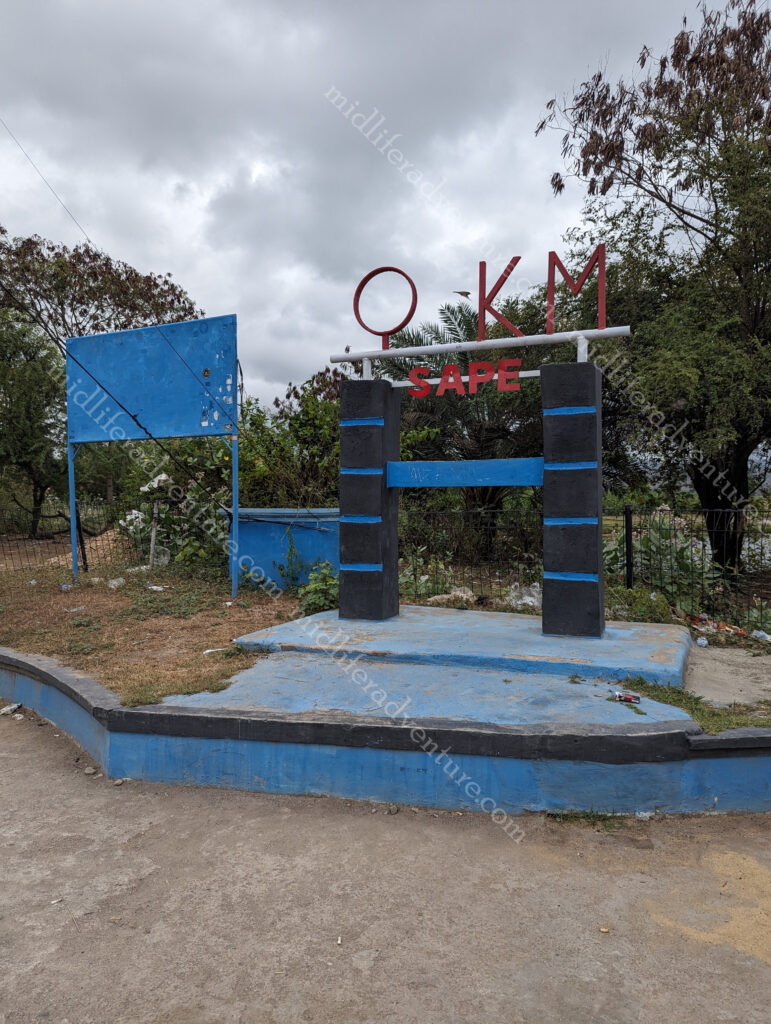
On the way, we were once again local superstars, especially among the school children who greeted us, waved, smiled, high fived, and fist bumped us every step of the way. Having milled about at the intersection for a bit, there were no offers of transportation, and no obvious sign that there would be any. The night before we had seen (god bless google maps) that the local bus station was to the right, so we figured we would walk in that direction while we waited for our ride.
As we wandered a local lady stopped her motorbike (with her son on the back) so that her son could say hello, practice his English and introduce himself to us (as well as shake our hands). Did I mention that we were quickly becoming the talk of the town. When she found out we were headed to the bus station she looked mortified. Saying “no too far, too far”.
She then rode off, stopped a few hundred meters up the road and handed her phone to me, when we caught up again. It was her brother, who spoke better English, who proceeded to tell me that we were over 5km from the bus station and that it was a very long walk in the heat. I thanked him, and her, and the son and took the hint.
At this point I hailed down a ute, that seemed to pass as the local taxis. Asked for a lift to the bus station (Terminal Bis), he nodded and Jill and I hopped in the back of his ute. The back of the ute was filled with fish from the harbour, and what I hailed down was not a local taxi, but rather just some dude on his way back fro mthe fish market. Anyway, we had successfully hitchhiked and he happily drove us to the Bus station. Jill sat perched on a polystyrene box full of fish while I stood on the back, ducking low lying branches every time we passed a tree.
Now if we were the talk of the town before, the sight of Jill sitting amid the fish and some big monster ducking trees as he perched high above this ute, really sealed our fate. I am certain that our visit will be talked about for a while to come.
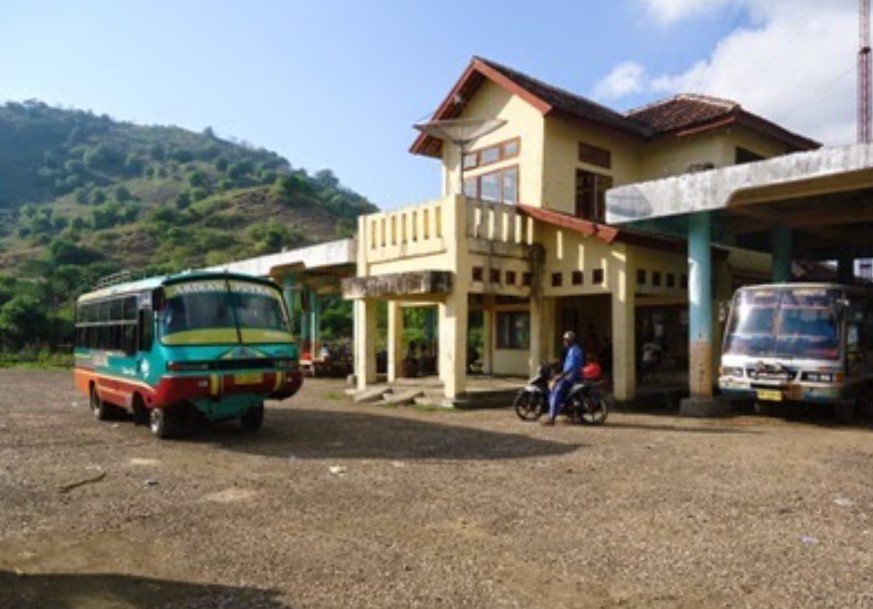
Our mate (as it happened) was not a local taxi, just a bloke willing to help out. So we flinged him $5 and thanked him greatly as we got off at the Terminal Bis.
The bus station was hovel in the middle of nowhere, with some of the shittiest buses that you have ever seen. We negotiated our tickets (at seemingly highly inflated westerner prices) and got on the dodgiest bus that either of us had ever ridden in (which after India is really saying something). We sat in the back seat, the door next to me would not close and within the first five minutes we had blown a tyre.







We passed the true version of rural Indonesian life. There was corn drying by the roadside, every type of landscape that you could imagine and of course roaming gangs of monkeys (tree rats). All of this highly visible and accessible through my open door.
At one point we even passed a truck that had fallen off the side of the road and was laying on its side in the gutter.
There was a crowd of people scratching their heads about what to do about this.
But it reassured us that the idea of staying the night in Sape was a good one, rather than try to negotiate that road at night.
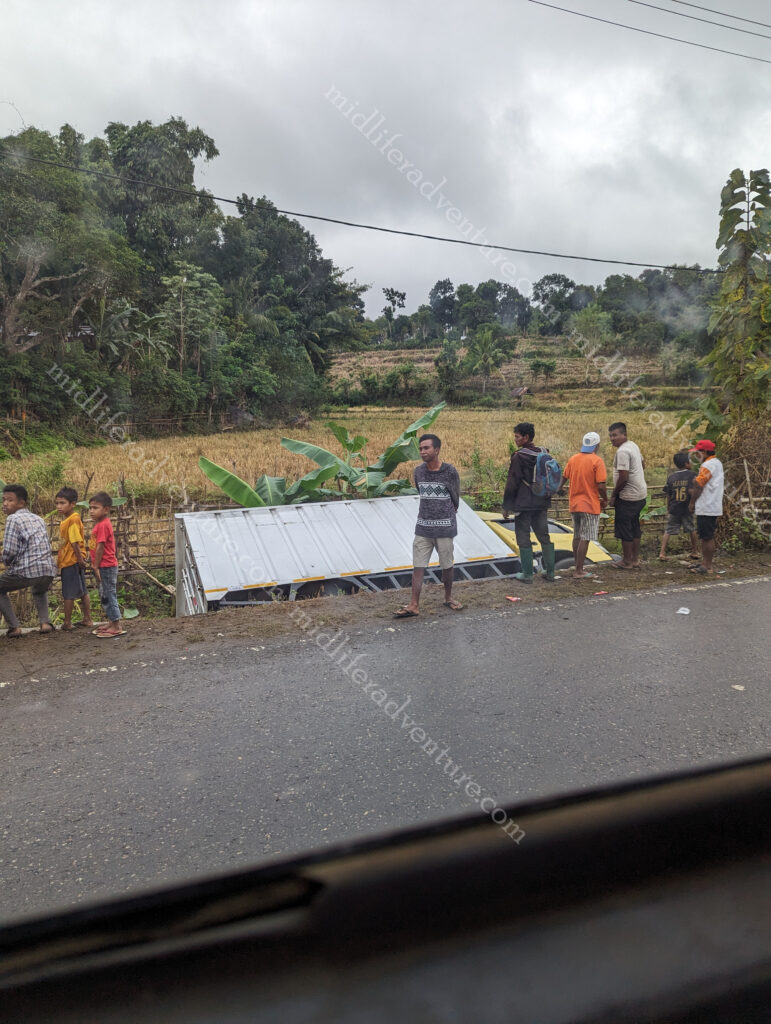
At one point it was time to pay. So the driver came around to get the money and the exorbitant Westerner rate they had quoted disappeared and he only took $5 for the both of us. Whether this was a miscommunication or a burst of conscience, but we travelled the 2 hours across the island for $5.
Bima
Bima was the big town (about 150,000) on Sumbawa and was the home of the airport that would get us out of here and back to something resembling civilisation. But first we would poke about, have a look and spend the night. Needless to say that our bus ride dropped us at a similarly dodgy bus terminal at the other end of the island.
Thankfully Grab worked here (which it did not do in Sape) and we were able to get a car to the hotel that we were booked into. The alternative was that Jill and I would sit pillion on a scooter each while they drove us the 14km, up the steep hill, with our bags to where we would stay. But first we would have to hear all of the touts telling us that no car would come for us and that the only option was the bikes. This continued right up to when the car arrived.
Having got to our hotel we then found that it did not serve food, and that there was nothing within about 5km of us. We decided to order food from the Grab app and have it delivered. This was able to be achieved simply and seamlessly.
Our foray into the less touristy areas of Indonesia was highly enlightening for us. While it is manageable it is quite challenging once you get off the beaten path. Too many tourists is not great, but you do still need enough so that you are not a curiosity having to hitch hike in the back of fish trucks.
Lombok
Lombok is east of Bali and west of Sumbawa and is part of the Lesser Sunda Island chain.
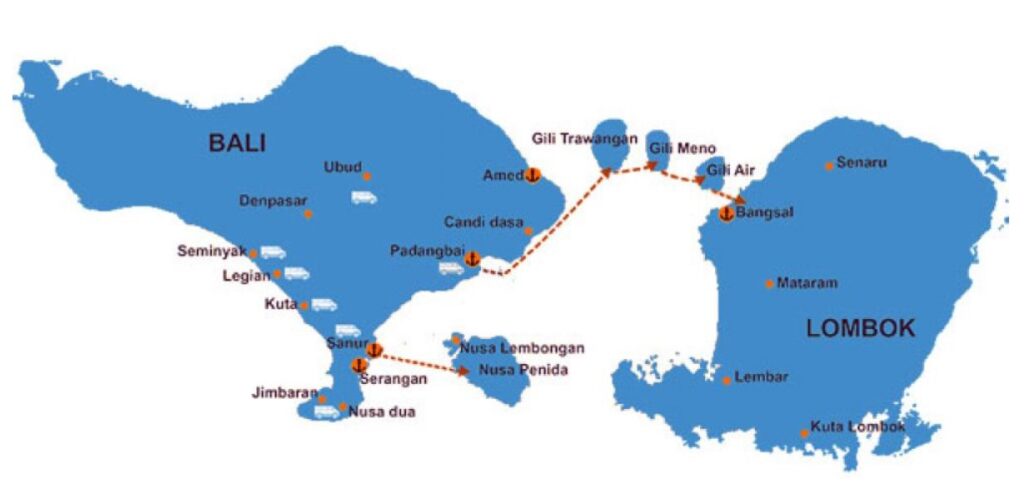
It’s known for beaches and surfing spots, and was somewhere that I had visited, way back when. Our time in Lombok was really more about relaxing rather than racing about to see things. Jill had us booked into a lovely hotel, so when the rain started, we just kicked back and enjoyed some quiet time.






If we had been more motivated, Lombok does offer a fair old range of sights to see. Nothing startling, but the usual mix of Indonesian style attractions, tons of beaches, snorkelling, volcanos. trekking, waterfalls and rice terraces etc.
But our interest, and the reason for coming, lay in the Gili Islands.
The Gili Islands
The Gili Islands (the word “Gili” means “small island”) are a trio of islands off the northwest coast of Lombok. All share similar traits but each has its own style and character. They are all fringed by white sand beaches and all have banned motorised transport. This gives you a small respite from the usual Indonesian traffic.
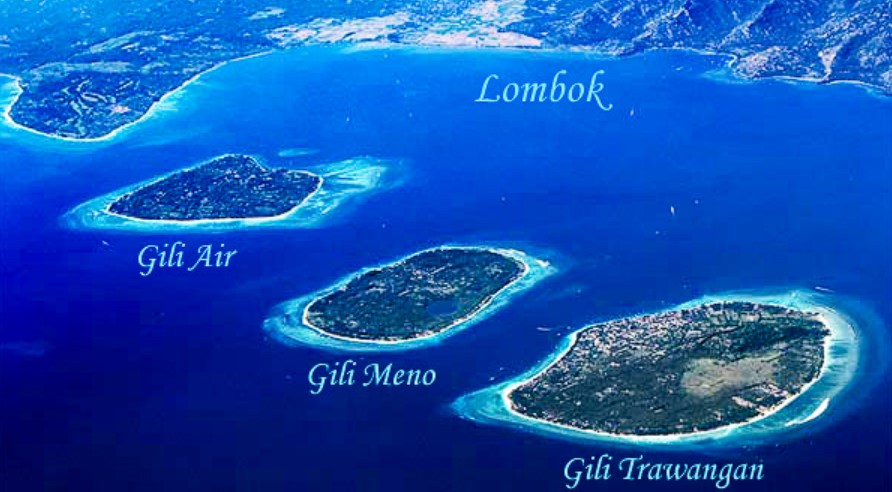
You can literally go swimming and snorkeling off the shore from anywhere in any of the Gili islands. The islands are home to coral reefs, colourful fish, small reef sharks, sea turtles, and even a few underwater statues. But be warned…there will be lots of people trampling and ruining the reefs. What was probably once an idyllic location is becoming increasingly ruined.
If you didn’t bring your own snorkeling gear, it’s easy to rent a mask, flippers, and a snorkel at any of the dive shops in town or even from locals on the beach.
Gili Trawangan
Getting here from Lombok was a simple car ride to the port and a few dollar (30 minute) boat ride across the water. We had the option of the fast boat or the local boat. The fast boat ($8.50) left on the hour every hour and took 20 minutes while the local boat was cheaper (about $2.25) and had a more laissez-faire timetable. Being in no particular rush, and having just missed the 11am fast boat, we opted for the local boat.
This had multiple benefits, the boat left when it was full (which happened every 20-30 minutes or so) so we were on Gili T before the fast boat was even due to leave.
The local boat drops you on the beach, away from the dock, so you also avoided having to pay the island tax ($2) on arrival.
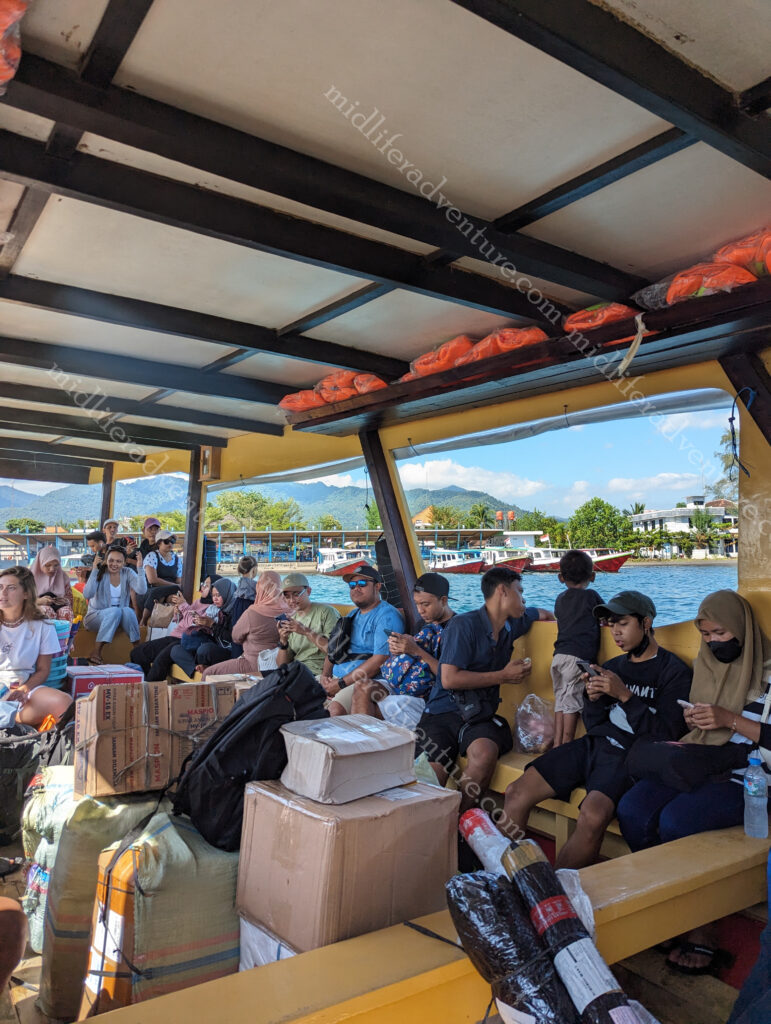
Gili Trawangan is where we stayed, it is the more developed of the islands with a buzzing beach strip, bars and restaurants and is the launching point for most of the tours, ferries and day trips.
The island is about 3 km long and 2 km wide with a permanent population of around 1500 and at least that much again (if not much more) in daily tourist influx.
On Gili Trawangan (as well as the other two Gilis), there are no motorised vehicles.
The main means of transportation are bicycles (rented by locals to tourists) and cidomo (a small horse-drawn carriage).
For travelling to and from each of the Gilis, locals usually use motorised boats and speedboats.
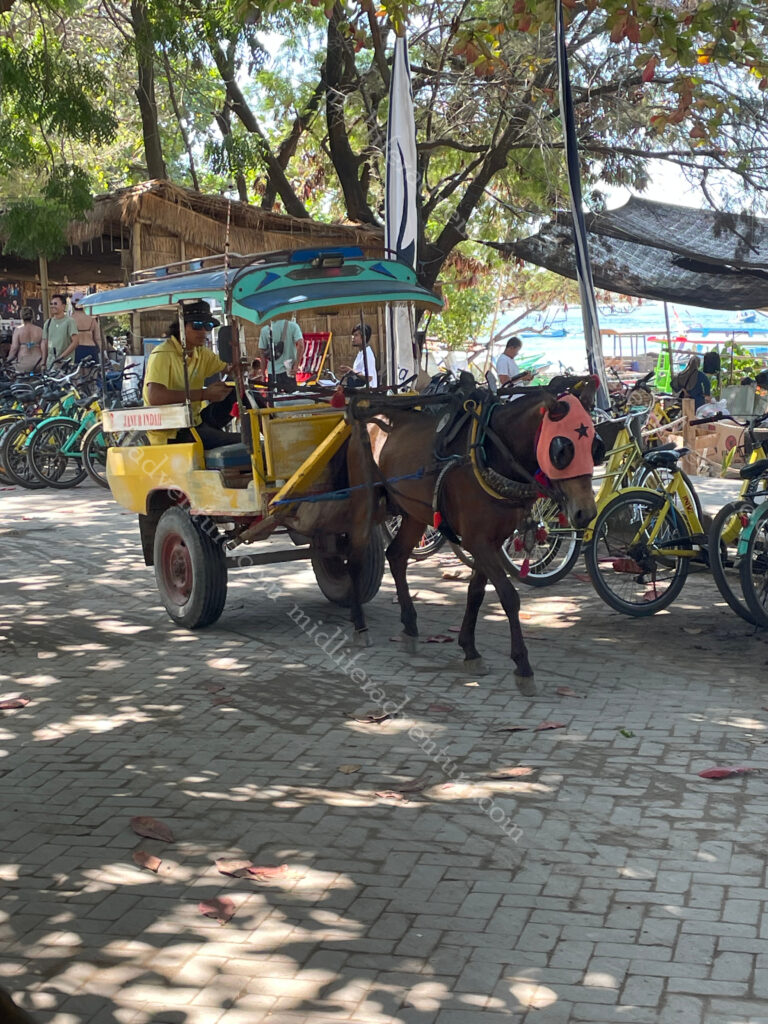
Most people rent bicycles to get around. There is only one main road on the island so if you just follow the road, you will ring the island within about an hour. You can rent a bicycle for $5 a day or $1.50 an hour. But beware, there are many uncoordinated and not road wise people who also rent them who are a danger to themselves and others. Not to mention many pedestrians with their heads up their ass.
A short walk to the hotel, get settled, a swim, line up our snorkelling adventures for the next day and find a sport for dinner. And what a spot we found. Feet in the sand, sunset views, cheap food, great service, daily catch seafood, western and local menu, reasonably priced beer and 3 cocktails for $10. We ended up eating here all 3 nights.







Gili Trawangan has had a reputation since the 1980s as a location where magic (Psilocybin) mushrooms are openly advertised and sold. Police presence is low and within the last 10 years finding drugs on Gili Meno and especially Gili Air has become very easy. On Gili Air intense psychedelics are being sold openly to tourists for beach parties. While the police presence is low, Indonesian drug laws remain extremely harsh. Drug possession and use is prohibited and carries potentially grave risk (up to and including the death penalty).
There are several beaches in Gili Trawangan, all offering epic views, perfect swimming conditions, and plenty of beachside stalls, restaurants, and bars where you can grab a bite or enjoy a freshly cracked coconut.
Gili Meno
Gili Meno is the quietest of the Gilis and is mostly for couples and honeymooners. It has a few stylish boutique resorts (read expensive… comparatively) that are favoured by couples seeking an idyllic escape on pristine beaches. It has virtually no nightlife and very few restaurants (that are not attached to the resort).


The main attraction of Gili Meno is the sunken statue sculpture that sits just off the beach.
It was commissioned by the local eco-resort and was created by British sculptor, Jason deCaires Taylor. It consists of 48 life-size statues, formed into a circle. Embracing figures surround curled up statues on the ocean floor. It has become a must do stop for Instagrammers and punters alike, all seeking photos like the one above.
But the reality is quite different. Every boat, every snorkelling tour will take you here, typically all at the same time so rather than getting this view, you are fighting about 150-500 of your closest friends to get your idyllic photo.
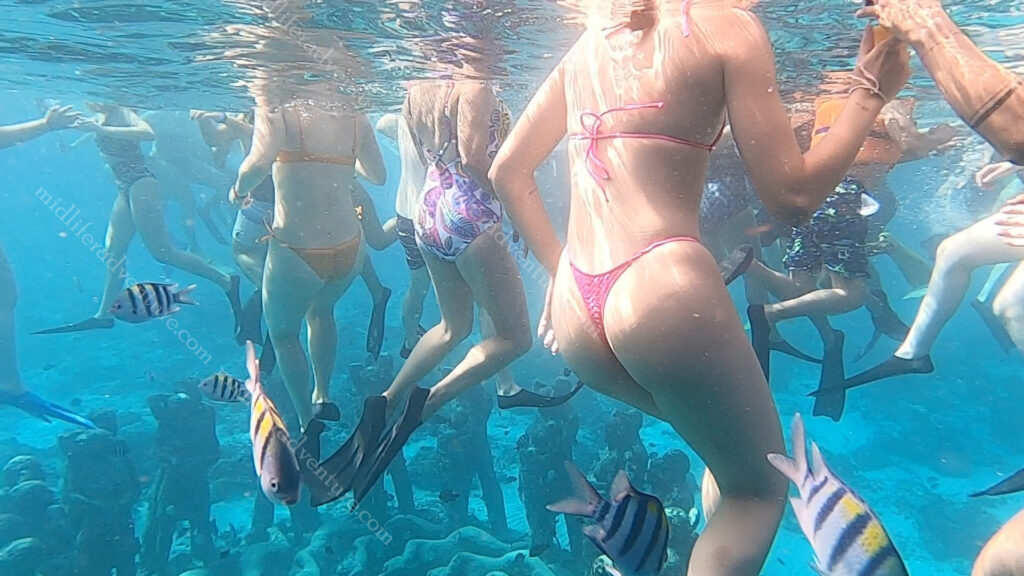
The next stop was onto the beach where you find yourself at the turtle sanctuary. This is where you get to see the tiny turtles that had the eggs saved from predators (ghost crabs, dogs, cats monitor lizards, foxes, monkeys etc.) were hatched and raised for 1 year until they are strong enough to be released.



From here it is off to turtle point, where you are virtually assured to see and swim with turtles. But much like the statues, there are several boat loads of people all stalking the same few turtles that are just trying to get a feed. So you are met with the bizarre circumstance of about 100 people in the water chasing after some poor unsuspecting turtles. But that said, you can get some great photos and while we were there, nobody tried to harass or touch the turtles.








Gili Air
Gili Air is the smallest of the islands and is the closest to Lombok, it has a few bars and a bit of accommodation, but on a much more affordable and laid back style than the other two islands. It is the only island in the Gili islands that has its own water table which it can draw fresh water from.
Gili Air has the best of (least trampled) the snorkelling and some bits set up just for the Instagrammers (water swings etc).

Penida Island
Nusa Penida is a relatively undeveloped island south-east of mainland Bali. It is mostly a day trippers island, being only a short hop from both Bali and Lombok, You won’t find snazzy beach clubs, organic cafes or trendy restaurants here, but Nusa Penida is still worthy of a visit. It houses some of the most photogenic sights in Bali.
The main reason people (Instagrammers) come is to get a photo with the rocky outcrop shaped like a T-Rex. The island scenery is pretty spectacular with some pretty amazing cliffs and beaches, but you do need to work to get to them.



If you spend the night on the island this is easy as you can go early in the morning, before the day trippers arrive. But if you sleep in it quickly becomes a nightmare. The first of the ferries and fast boats tend to leave at around 8am so by 8:30 the hordes are arriving. The roads on the island are single lane and full of potholes. Everyone is going to the same places and you end up in a line of traffic and then a line of people all looking for the same photograph.



The same then happens when it comes to lunch and snorkelling, before they all fight for the jetty and dock to go back to either Bali or Lombok. The best way is to arrive mid-late morning with the intent of spending the night and do the tour in the afternoon while the day trippers are all scrambling home. Then you can have a leisurely breakfast the next day and leave on one of the many departing fast boats.
Sanur
Having arrived at Sanur in Bali it was a simple (eventually) matter of getting a Grab and heading to the boy’s place. I say eventually as the taxi industry had taken over the port and had banned all ride share companies access. This meant that you had to schlepp it out of the port for about 1.5 km before the Grab driver could pick you up.
This was not really the issue. The main issue is that you get set upon every step of the way by some of the most aggressive and pushy touts that we have come across in some time.
Anyway, we made it back for some kick back for a few days before launching on our next round of island hopping.